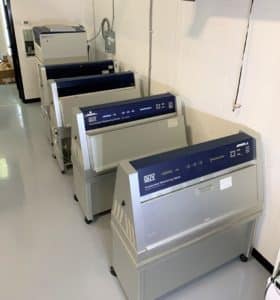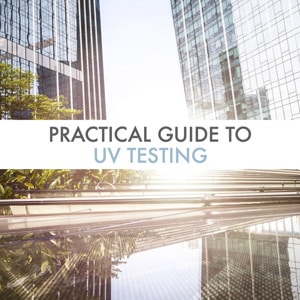SAE J2020
Accelerated Exposure of Automotive Exterior Materials Using a Fluorescent UV and Condensation Apparatus
SAE J2020 testing is offered by Micom as part of its Automotive testing and SAE Testing services. SAE J2020 is used to do a UV testing , which assesses the resistance of automotive exterior materials after an accelerated weathering. This test method is centered on ASTM G-154 .
Automotive exterior materials accelerated exposure test use and factors to consider:
 SAE J2020 is an accelerated aging test which allows foreseeing the effects of heat and sunlight on the performance of external car parts over time. Indeed, this is done by subjecting them to a weather condition that may appear on the exterior of a car. That situation is based on the use of UV lights and on an environment that has a high level of humidity and heat. In fact, SAE J2020 allows using either UVA or UVB fluorescent lamps. Lastly, with the help of the data collected from the test, it possible to characterize the evolution of the properties of the material under normal conditions.
SAE J2020 is an accelerated aging test which allows foreseeing the effects of heat and sunlight on the performance of external car parts over time. Indeed, this is done by subjecting them to a weather condition that may appear on the exterior of a car. That situation is based on the use of UV lights and on an environment that has a high level of humidity and heat. In fact, SAE J2020 allows using either UVA or UVB fluorescent lamps. Lastly, with the help of the data collected from the test, it possible to characterize the evolution of the properties of the material under normal conditions.
As outlined in our UV testing eBook , accelerated fluorescent UV exposure is principally used to appraise the loss of mechanical properties as well as yellowing i.e., no color fading. Should you be mainly concerned with aesthetics properties, you should consider using SAE J2527 , because its purpose is to portray the color change over a specific time span.
Typical Experimental parameters:
The number of samples required is one, however, duplicates are desirable. The typical sizes of the sample are: 50 mm X 75 mm, 75 mm X 100 mm, 75 mm X 150 mm (most standard size), 100 mm X 150 mm.
The SAE J2020 test is initiated by the condensation cycle and the samples are examined weekly during the condensation cycle in order to ensure the presence of condensation. The cycle parameters and the characteristics of the UV lamps are stated in table 1 and 2 respectively.
Table I: Description of the cycle parameters for SAE J2020 method
| Cycle | Time exposure | Temperature |
| UV light | 8 h | 70 °C |
| Condensation | 4 h | 50 °C |
Table II: Characteristics of the UV Irradiance
| UV lamps | Irradiance level | Wavelength |
| UVA | 0.41 to 0.55 W/m2/nm | 310 nm |
| UVB | 0.67 to 0.77 W/m2/nm | 340 nm |
Other test methods related to SAE J2020:
For additional related test methods, please see; ISO 4892-3
If you have any questions about the SAE J2020 test, we invite you to contact our material testing lab today. It will be our pleasure to answer your questions and help you with your custom material testing requirements.
Practical UV Testing Guide
Sunlight exposure can have harmful impacts on carbon-based
materials such as coatings, polymers, textiles, and many others.
Learn more about our in-laboratory UV testing process in this guide.


